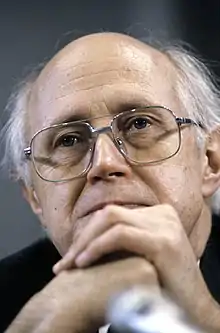Cello suites (Britten)
The cello suites by Benjamin Britten (Opp. 72, 80, and 87) are a series of three compositions for solo cello, dedicated to Mstislav Rostropovich. The suites were the first original solo instrumental music that Britten wrote for and dedicated to Rostropovich, but Britten had earlier composed a cadenza for Joseph Haydn's Cello Concerto in C major, for Rostropovich, in 1964. Rostropovich gave the first performances of each work, and recorded Suites Nos 1 and 2 commercially.[1]
| Cello suites | |
|---|---|
| by Benjamin Britten | |
 Cellist Mstislav Rostropovich, who inspired and first performed the suites dedicated to him | |
| Catalogue | Op. 72, 80, 87 |
| Genre | Suites |
| Performed |
|
Cello Suite No. 1, Op. 72
Britten wrote the First Suite at the end of 1964. The premiere was at the Aldeburgh Festival[2] on 27 June 1965.[3] The suite is in nine movements, played without pause:
- Canto primo: Sostenuto e largamente
- Fuga: Andante moderato
- Lamento: Lento rubato
- Canto secondo: Sostenuto
- Serenata: Allegretto pizzicato
- Marcia: Alla marcia moderato
- Canto terzo: Sostenuto
- Bordone: Moderato quasi recitativo
- Moto perpetuo e Canto quarto: Presto
The score was published in 1966.[4]
Cello Suite No. 2, Op. 80
The Second Suite dates from the summer of 1967. Rostropovich gave the premiere at the Aldeburgh Festival, Snape Maltings, on 17 June 1968. The score was published in 1969.[5] The movements are as follows:
- Declamato: Largo
- Fuga: Andante
- Scherzo: Allegro molto
- Andante lento
- Ciaccona: Allegro
Cello Suite No. 3, Op. 87
Britten composed the Third Suite in 1971,[6] inspired by Rostropovich's playing of the unaccompanied Cello Suites of Bach. Rostropovich first performed the suite at the Snape Maltings, 21 December 1974. In 1979 the Britten Estate authorised Julian Lloyd Webber to make the suite's first recording.
The Third Suite is in nine movements, performed without pause:
- Introduzione: Lento
- Marcia: Allegro
- Canto: Con Moto
- Barcarolla: Lento
- Dialogo: Allegretto
- Fuga: Andante espressivo
- Recitativo: Fantastico
- Moto perpetuo: Presto
- Passacaglia: Lento solenne
The work incorporates four Russian themes, including three arrangements of folksongs by Pyotr Ilyich Tchaikovsky,[7] reminiscent of Beethoven's use of Russian themes in the Razumovsky quartets. The final Russian tune, stated simply at the end of the set, is the Kontakion, the Russian Orthodox Hymn for the Dead. Philip Brett considers the Third Suite to be the most passionate of the three.
References
- Anderson, Robert (1970). "Record Review: Britten: Two Suites for Cello, Op 72 and Op 80. Rostropovich. Decca SXL 6393". The Musical Times. 111 (1532): 1005. ISSN 0027-4666. JSTOR i239384..
- Walsh, Stephen (Autumn 1965). "First Performances: Three New Britten Works". Tempo. New Series (74): 23–24. ISSN 0040-2982.
- Mann, William (1965). "Festival Reports: Aldeburg (August 1965)". The Musical Times. 106 (1470): 615–18. ISSN 0027-4666. JSTOR 949333.
- Tilmouth, Michael (1967). "Review of Music: Britten, Benjamin, Suite, Op. 72". Music & Letters. 48 (3): 293. JSTOR 732740.
- Tilmouth, Michael (1970). "Reviews of Music: Second Suite, Op. 80". Music & Letters. 51 (1): 92–93. JSTOR 733210.
- Evans, Peter (July 1977). "Reviews of Music: Canticle V: The Death of Saint Narcissus, Op. 89; Third Suite for Cello, Op. 87". Music & Letters. 58 (3): 352–353. JSTOR 734064.
- Anderson, Robert (1981). "Record Reviews: Bridge/Britten/Ireland". The Musical Times. 122 (1660): 388. JSTOR 960975.
Sources
- Philip Brett: "Benjamin Britten", Grove Music Online, ed. L. Macy.
- Aquino, F. Avellar de. "Song of Sorrow". in The Strad Magazine, London, v. 117, Vol. 1391, p. 52-57, 2006. (on Britten's Third Cello Suite)